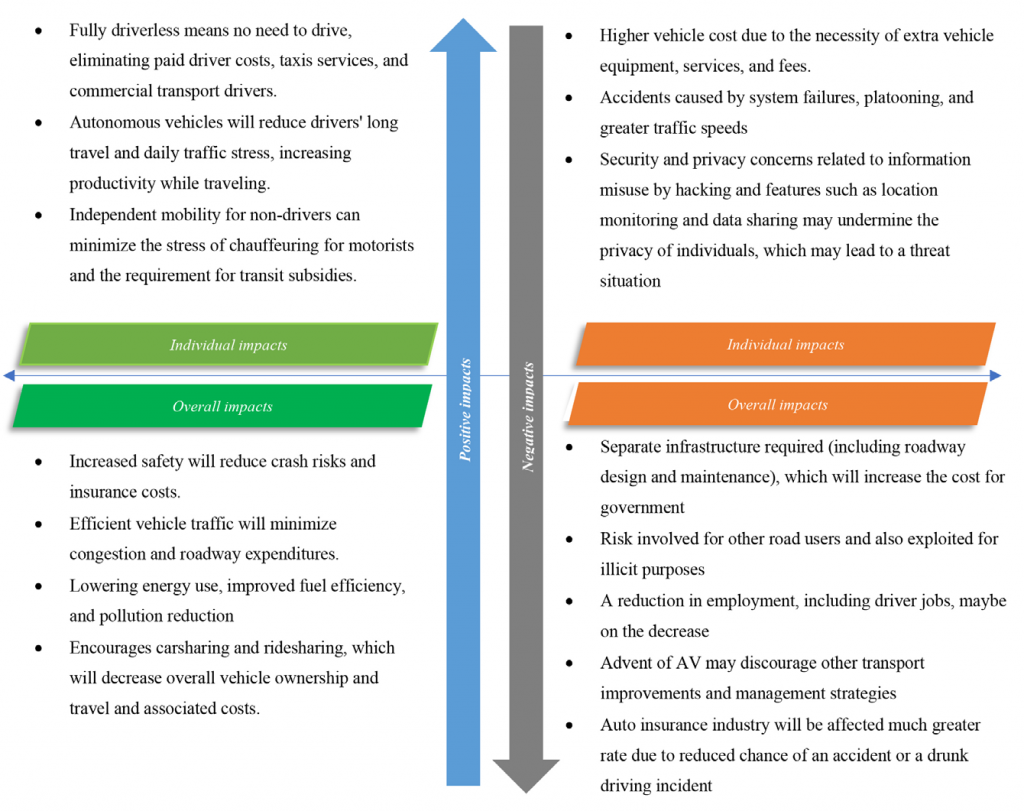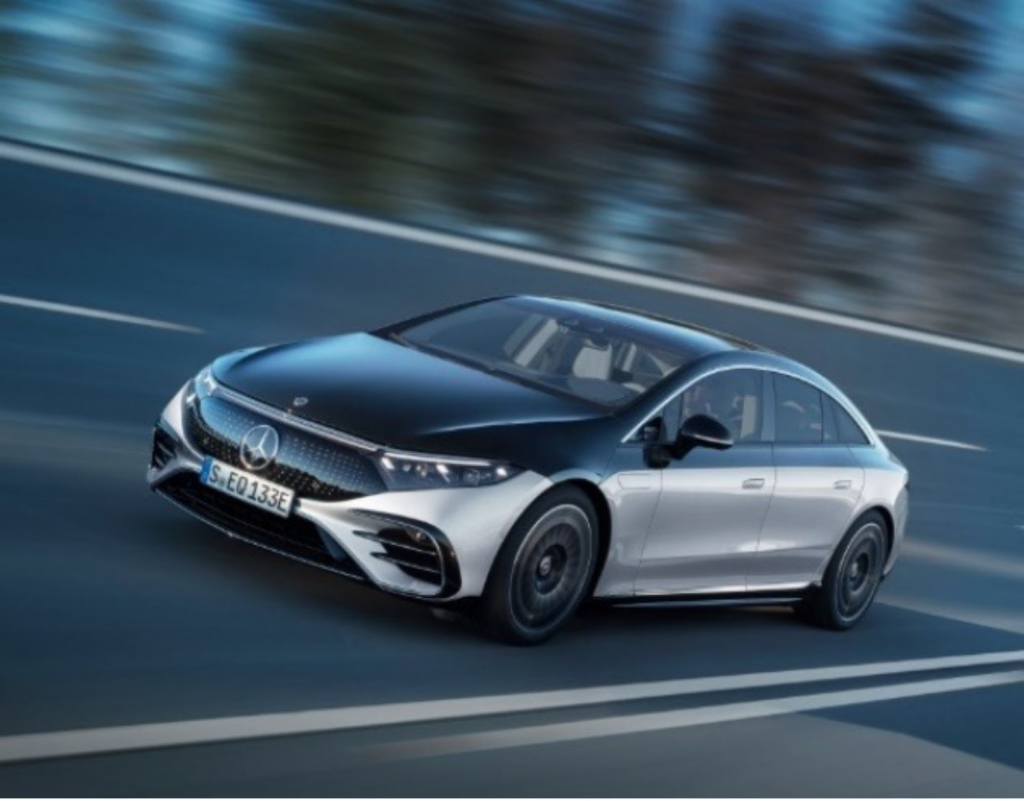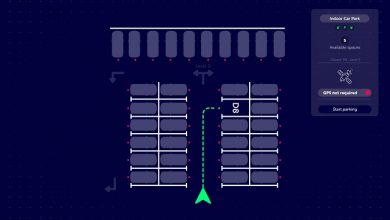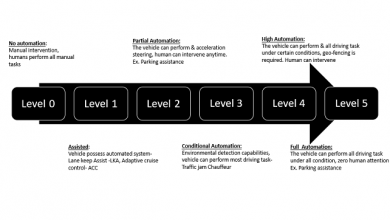Outlook on world autonomous vehicle and their impacts

For a long time, driverless technologies have promised to revolutionize urban transportation. Especially since manufacturers began reporting substantial achievements in automated driving technologies around 2010, there has been widespread concern about mass unemployment in transit systems and mobility-related industries such as trucking. The development of self-driving vehicles is accelerating, prompting several governments to enact legislation and rules governing the technology. These regulations are intended to address the new-wave autos’ safety, liability, privacy, and security concerns. For at least the next decade, fully autonomous driving will be limited to specific geographic regions and climates, with progressively automated mobility systems flourishing in the following decades. This timeframe allows policymakers to prepare for and minimize disruptions of millions of road transportation jobs and related industries likely to be affected while fostering substantial economic opportunities and supporting environmental impacts by developing accessible mobility systems for everyone.
Let’s look into a birds-eye view of how Autonomous Vehicles (AV) impact in positive and negative ways for individual owners and overall.

As we saw, there are various advantages and disadvantages which tag along with the upcoming new era of autonomous vehicles. But where in the world at present when it comes to autonomous vehicles? Are companies working hard to bring autonomous vehicles into the mainstream? How will the workforce training and education system align with this change? Are there any acquisitions and mergers worldwide to combine knowledge and technology for one vision? How do laws and legal systems support the autonomous dream to come true? Did COVID-19 impact the autonomous vehicle vision? Let’s go through every question!
Where is the world at present with autonomous vehicles?
When we think of autonomous cars, one name always comes to mind: Tesla. The dream of completely driverless cars, stacked into six levels by SAE, and the Tesla is at Level 2 of autonomy, but the company still implies that the vehicle is fully self-driven. Level 2 has been achieved by major global automakers such as General Motors, Volvo, Tesla, Nissan, and Toyota. But this year, 2021, the breakthrough of Level 3, achieved by two manufacturers, Honda (Model – Honda Legend) and Mercedes (Model -Mercedes-Benz S-Class and Mercedes-Benz EQS), as the name implies a step up. Level 3 means the car can read its surroundings (traffic Etc.) and make decisions based on them. Thanks to Honda and Mercedes, the world has reached Level 3 of autonomy, and it is expected that other companies will launch their Level 3 autonomous vehicles soon.

Are companies working hard to bring the autonomous vehicle into the mainstream?
The current pilot runs are primarily done in suburban areas. The success lies in driverless mobility-as-a-service (cars or trucks) deployment in densely-populated urban cities such as– Beijing-China, – London-UK, US – New York, San Francisco – U.S., and Tel Aviv- Israel. For instance, Waymo, Cruise, and Zoox test their driverless technology in San Francisco. Mobileye tests in New York City and also in Tel Aviv. Companies such as Didi Chuxing, AutoX, and Baidu are aggressively testing to reach the highest autonomy level in China. According to a study conducted by Alix Partners, the global investment towards making the autonomous vision possible is around $75 billion in technology between 2019 and 2023. But during this timeline, the COVID-19 pandemic happened, but did it impact the autonomous vision? We will discuss this later in this article. The global deployment of such technology with no human intervention will take at least a decade or more. Moreover, the expansion will be gradual since companies are still testing for advanced driverless technology, and deployment will happen stage by stage in various regions of the world for specific transportation categories.
How will workforce training and education systems be aligned with autonomous technology?
The technology change will highly affect trucking jobs, bus driver jobs, and car driver jobs positively and negatively since it’s a double-edged sword. It will end some positions and also create a new stream of employment. Driver jobs are not limited to just driving, but other tasks, including vehicle check-up, breakdown and vehicle maintenance, loading, and securing, among others. The emerging A.V. industry will open gates for more off-the-road tasks (teleoperation centres) such as emergency management, customer care, auto repairs, and registration/booking, which will provide jobs for many drivers. With proper training, the drivers can take up any off-the-road tasks, which will save the careers of many drivers. Continued investment in workforce training, or other strategies to address job and market change, is critical.
In terms of the education system, new generation colleges are adding various new courses and academics to prepare a new generation of students in automation. Companies will need engineers and designers to help develop the next generation of vehicles that contain all of the necessary technology and sensors. Many companies currently offer positions that require a minimum of an undergraduate degree and some postgraduate degree or Ph.D. with additional experience in the field. But in the future, specifically for the autonomous area, it will be more of specific knowledge-based recruitment with a high degree, and companies are looking to reach a higher level of autonomy, which requires a high level of knowledge foundation.
Are there any mergers and acquisitions worldwide to combine knowledge and technology for one vision?
The automotive industry’s mergers and acquisition activity has been experiencing flat or declining. Many investors are cautious about automotive investments due to the stagnant situation in the automotive industry, which leads to uncertainty about which technologies would survive. But the problem is gradually changing due to increasing developments in electrified drivetrains and autonomous technology testing, which has opened up new gateways on the technology side. Many small and mid-size suppliers face liquidity issues, which opens up opportunities for various companies to buy out. Moreover, automotive companies’ valuation has been shrinking from the past 2 to 3 years, and acquisitions are an attractive method to increase the valuation and technology aspects of companies. Below are some of the significant acquisitions in the past six years.
List of major acquisitions
| Acquirer | Target company | Acquisition date | Value (M$) |
| Woven Planet Holdings | Lyft Level 5 | 04/26/2021 | $550 |
| Cognizant | ESG Mobility | 03/25/2021 | — |
| Luxoft | CMORE Automotive | 03/20/2021 | — |
| Cruise | Voyage | 03/15/2021 | — |
| Aurora | Uber ATG | 12/07/2020 | — |
| Amazon | Zoox | 06/26/2020 | 1200 |
| Velodyne Lidar | GRAF | 06/02/2020 | — |
| Intel | Moovit | 05/04/2020 | 900 |
| Waymo | Latent Logic | 12/12/2019 | — |
| Ford, Volkswagen | Argo AI | 07/12/2019 | 3600 |
| Apple | Drive.ai | 06/26/2019 | — |
| Daimler | Torc Robotics | 03/19/2019 | — |
| Delphi Automotive | nuTonomy | 10/24/2017 | 450 |
| Intel | Mobileye | 03/13/2017 | 15300 |
| GM | Cruise | 03/11/2016 | 1000 |
| GM | Lyft | 01/05/2016 | 500 |
How do laws and legal support autonomous dreams to come true?
In terms of law, many countries/regions have their own set of regulations to tackle autonomous vehicle adoption. There is no global regulation for the autonomous vehicle at present, as the 1968 Vienna Convention on Road Traffic, for regulating and establishing traffic laws. Among the different rules across the globe, some are specific laws, and some are strict, which quickly reduces the global adoption of the technology. The strict rules consist of many barriers, road conditions, climatic conditions, emotions, safety issues, Etc. Since this is a paradigm shift in the automotive industry, different countries are at various stages of the regulatory process because of the newness in technology. But it’s crucial to implement proper regulation for autonomous vehicles since it has many loopholes pertaining to the safety and security of the vehicle.
But in a few developing countries such as India, which is trying its best to be in-game with the modern technology, regulations on testing and legalization of autonomous vehicles is still lacking, and no proper consideration, yet the introduction of Tesla with autopilot is still questionable, will it run properly on the Indian roads? Issues for self-driving cars in India are no proper roads, no infrastructure to support, reckless driving with no attention to signals which causes accidents every minute across Indian cities. A new regulation was proposed in the Motor vehicles Act of 2017 for testing autonomous vehicles, but it’s still pending. But many countries are making more effort to implement the autonomous vehicle on their roads as soon as possible. Below is an overview of a few countries that have updated regulations to adopt autonomous vehicles in the past two years.
Updated regulations news in different countries
| Country | Regulation news |
| Australia | The guidelines for trials of automated vehicles were updated on 12/02/2020 by the National Transport Commission. The new policy is available on the NTC website. |
| China | The new national standards draft for automation classification was released on 03/09/2020 by the Ministry of Industry and Information Technology on their website. |
| Canada | The Federal Government of Canada has maintained consistency across all jurisdictions to promote autonomous vehicle development. In Ontario, to test level 4 and level 5 vehicles on the road, companies need to get green signals in line with Ontario’s A.V. Pilot Project regulations. In Quebec, for level 3-5, pilot run companies must obtain consent under an Act to amend the Highway Safety Code. |
| Germany | On 07/28/2021, the German Government passed a new law on autonomous driving for level 4 autonomous vehicles that can drive in regular operation in public road traffic (specified operating areas) |
| Hungary | On 09/18/2020, the Hungarian Government published its National A.I. strategy for supporting the development environment for research and infrastructure required for driverless technologies. The development period is for ten years, between 2020-2030. |
| South Korea | South Korea announced the new Autonomous Vehicle Act on 05/01/2020, providing driverless vehicles’ required infrastructure and support. Seoul to establish citywide autonomous driving infrastructure by 2026. |
| Turkey | A new Turkish regulation in line with E.U. rules will enter into force by 06/07/2022, pertaining to approval requirements for autonomous vehicles. Moreover, the Ministry of Transport and Infrastructure sets a new Action Plan for 2020-2023 to complete the building of Autonomous Driving Test and Certification Centers. |
| United States | On 01/11/2021, the U.S. Department of Transportation released a new Automated Vehicles Comprehensive Plan. The plan defines three main goals in line with USDOT’s vision for Automated Driving Systems (ADS). – Promoting collaboration and transparency regarding the capabilities and limitations of ADS – Modernize the regulatory environment to remove accidental and redundant barriers to innovative autonomous vehicles – Prepare the transportation system for evaluating the safety, efficiency, and accessibility of the transportation system. The full detail about the new plan is available on the U.S. Department of Transportation website |
Did COVID-19 impact the autonomous vehicle vision?
The global automobile sales volumes have been shrinking since 2017, and COVID-19 impacted a considerable time drop from 2019 to 2020. The market is expected to bounce back to 2019 levels by the end of 2023 or early 2024. COVID-19 impact on mobility will last for the long term as it drives change in the technology, macroeconomic environment, regulatory trends, and consumer behaviors. The COVID-19 has impacted the semiconductor industry colossal times, which led to chip shortage; it affected the entire automotive industry, including autonomous vehicles. Since the autonomous vehicle is embedded with many sensors and chips to automate the vehicle, the shortage of chips slowed down autonomous vehicle testing across the globe. But before the COVID-19 situation, many companies managed to stock the chips and sensors that helped them deploy autonomous technology to assist in various fields, including e-commerce, logistics, and healthcare. For instance, Beep and NAVYA partnered with Jacksonville Transportation Authority (JTA) to deploy autonomous vehicles to transport medical supplies and COVID-19 tests at Mayo Clinic in Florida. However, self-driving technology companies, including Waymo, Cruise, and Uber, have partially suspended their autonomous car testing with backup driver’s operation due to the spread of the coronavirus.
Final Verdict:
The pandemic’s effects on mobility have opened various opportunities to innovate sustainable and urban mobility. It is vital for the private sector and governments worldwide to coordinate at the local and federal levels to launch a proper strategy that will benefit everyone in the autonomous vehicle ecosystem, including customers. Many research and developments are advancing into driverless technologies rapidly across the globe. Various companies and countries are aggressively investing and releasing new regulations to make inroads into a driverless future as soon as possible.
Author:

G Naveen Kumar
Lead Analyst
Comscore, Inc.
Naveen Kumar has seven years of experience in management consulting, handling several large-scale strategic projects for various industries, including Automotive, Logistics & Transportation, Financial, and Healthcare industries. He loves to work on freelance projects to gain more industry knowledge, projects based on market research, strategy consulting, and analytics. He is currently working with Comscore, Inc.
Published in Telematics Wire





